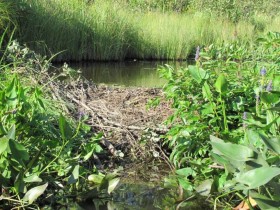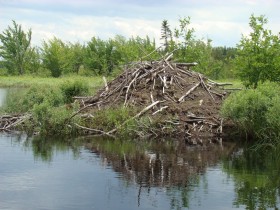are the largest of rodents. They have flat, scaly tails, and large front teeth. Beavers use their teeth to cut down and dismember small trees to use in construction projects: their homes (lodges) and dams to surround their lodges with water. Access to the lodges is underwater, so most bothersome animals cannot get in.
They are found throughout Maine, including as noted in the photos below, at Dresden Bog in the south and at Lobster Lake, east of Moosehead. See a beaver splashing in a video of a canoe trip in the Penobscot River East Branch in Soldiertown Township near Route 11 in Penobscot County.
Beavers have been trapped for their fur since before the Europeans arrived in Maine. The Indians harvested beaver in a sustainable manner, based on the native peoples’ scattered population and on hunting rights assigned their kinship groups. Beginning in the 1600’s, they traded these and other furs with the Europeans. Now a valuable trading commodity, rather than a resource for sustaining the traditional native lifestyle, beavers where trapped more intensively. William Cronon notes:
In response, Indians extended their hunting of furbearers to seasons when those animals had not been traditionally taken, and winter subsistence activities which had earlier relied on a wide range of species turned increasingly to the handful that had become tradable commodities. . . .
What encouraged the destruction of the beaver . . . was less new technologies than new market relations. Because supplies of the animal lasted much longer in the north than in the south, norther Indians developed a new set of institutions for controlling the hunt.
Today, trapping seasons vary by locations within the state, generally from November to the end of April.
| Size | Habitat | Food | Litter | Born | Behavior |
| L=35-46″ T=11-17″ 14-68 lbs |
Rivers, streams, marshes, lakes, ponds |
Vegetation, tree twigs, water plants |
4-5 | April- May |
Nocturnal; cut trees, build lodges and dams |
More Videos!
Additional resources
Cronin, William. Changes in the Land: Indians, Colonists, and the Ecology of New England. New York. Hill and Wang. 1983. pp. 64, 105 and others.
D’Elia, Jesse. Effects of Trapping on the Demographic Characteristics of Beaver in South-central Maine with a Reevaluation of Age Prediction Models. 1996. (Thesis (Honors)–University of Maine, 1996) [University of Maine, Raymond H. Fogler Library, Special Collections]
Maine Department of Inland Fisheries and Wildlife.
Rose, Guy E. Trapping Maine Beaver and Fisher. Published between 1940 and 1960. [Maine State Library]



